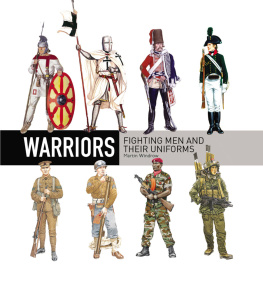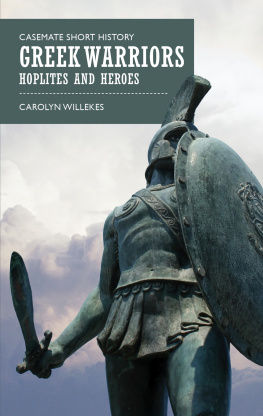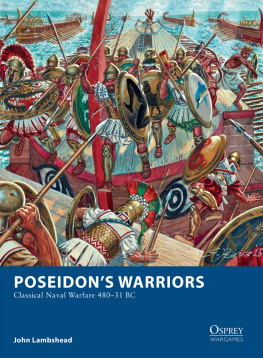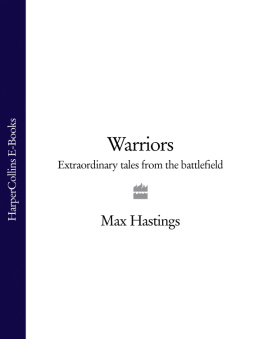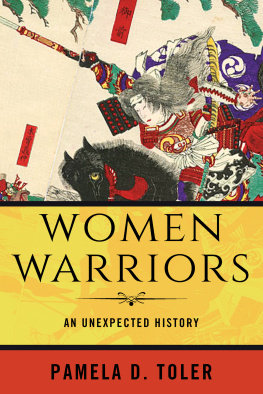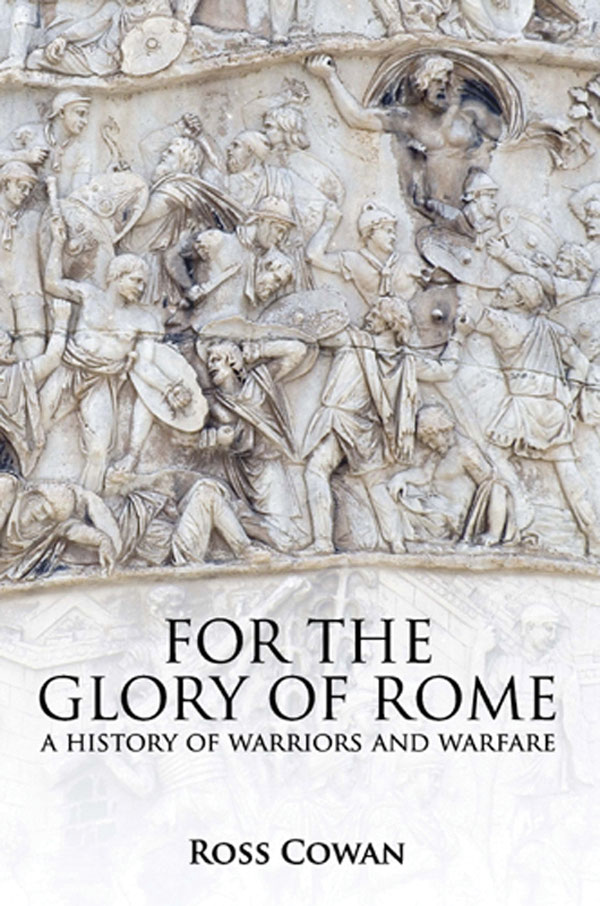FOR THE GLORY OF ROME
FOR THE GLORY OF ROME
A History of Warriors and Warfare
Ross Cowan
A Greenhill Book
First published in 2007 by
Greenhill Books, Lionel Leventhal Limited
www.greenhillbooks.com
This edition published in 2017 by
Frontline Books
an imprint of Pen & Sword Books Ltd,
47 Church Street, Barnsley, S. Yorkshire, S70 2AS
For more information on our books, please visit
www.frontline-books.com, email info@frontline-books.com
or write to us at the above address.
Copyright Ross Cowan, 2007
ISBN: 978-1-47389-876-9
eISBN: 978-1-47389-878-3
Mobi ISBN: 978-1-47389-877-6
All rights reserved. No part of this publication may be reproduced, stored in or introduced into a retrieval system, or transmitted, in any form, or by any means (electronic, mechanical, photocopying, recording or otherwise) without the prior written permission of the publisher.
CIP data records for this title are available from the British Library
CONTENTS
ILLUSTRATIONS
Legionary from the time of the Pyrrhic War
Ludovisi Battle Sarcophagus, detail
Capestrano Warrior statue
Phalangite from the time of Pyrrhus
Wall painting of Jupiter from Pompeii
Battlefield trophy sculpture
Dying Gaul statue
Portonaccio Battle Sarcophagus, aquila carried into battle
Duel of Manlius Torquatus and the Gaul
Funerary relief of Minucius Lorarius
Minucius Lorarius in full battle gear
Roman general on the Portonaccio Battle Sarcophagus
Battle of the Milvian Bridge
Praetorian standard
Roman army storming a city
Arch of Titus
Centurion of the fourth century
AD
Bellator of legio XXII Primigenia
Sabellian warriors
Helmet of a Senones chieftain
Montefortino helmet
Sarcophagus of Scipio Barbatus
Ludovisi Battle Sarcophagus
Ludovisi Battle Sarcophagus, detail
Lightning Miracle on the Aurelian Column
Rain Miracle on the Aurelian Column
Emperor Constantius with Labarum standard
Battle scene from Trajans Column
Assault on a Dacian fort, from Trajans Column
Inscription of Marcus Billienus
Coin showing Marcellus and the spolia opima
Coin depicting Marcus Sergius Silus
Aurelian Column scene
Centurion on the Portonaccio Battle Sarcophagus
Legionary of the first century
BC
Caesars defences at Alesia
Centurions gladius
Marcus Aurelius Lucianus
Cenotaph of Marcus Caelius
Imperial praetorians
Ninth Legion tile stamps
Epitaph of Aelius Asclepiades
Building inscription from York
Sling bullets from the siege of Perusia
Scene from Trajans Column
ACKNOWLEDGEMENTS
I would like to thank Michael Leventhal and Henry Alban Davies of Greenhill Books for commissioning this title and guiding it towards publication. Editor Donald Sommerville expertly crafted my rough and ready manuscript into this handsome book. Dr. Duncan B. Campbell and Professor Lawrence Keppie freely lent their great expertise on the armies of the Hellenistic kingdoms and Rome, and sections of this book are the better for it. Needless to say, any errors are those of the author. When I was unable to consult his A Commentary on Livy, Books VIX. Volume 4: Book X (Oxford, 2005), Professor Stephen P. Oakley kindly sent me copies of his files which greatly benefited my treatment of the battles of Camerinum and Sentinum (see Chapter II). From my vague outlines Graham Sumner painted the vivid reconstructions of Roman warriors which add so much to this volume. Johnny Shumate provided the splendid illustration of a sarissa-wielding phalangite, that determined opponent of the legionary at the battles of Heraclea, Ausculum and Malventum (see Chapter I). The enthusiasm and encouragement of Jim Bowers sped this book to a conclusion. Jim also provided the illustration of a bellator of legio XXII Primigenia in the grip of battle lust. Jasper Oorthuys and Steven D. P. Richardson supplied illustrative material, as always.
Special thanks are due to the Cowan family, Thomas McGrory and Krista Ubbels for their support and interest in this project.
This book is dedicated to the memory of David Gemmell. He wrote about warriors and heroes, many of them ancient Greeks and Romans. His novel Ghost King introduced me to the legend of the Ninth Legion and ignited my interest in the Roman army.
Ross Cowan
PREFACE
Since the publication of For the Glory of Rome in 2007, the two topics that have most interested readers are the Ninth Legion and single combat.
For a re-appraisal of the evidence concerning the disappearance of the Ninth Legion, readers are directed to Dr Duncan B. Campbells essential article, The Fate of the Ninth, Ancient Warfare 4.5 (2010), 4853.
Between the duel of Jonathon and Priscus at Jerusalem in 70 and the grand resumption of the practice in the sixth century, there are few instances of single combat. The best example is the defeat of a Persian Immortal by the lasso-wielding Count Areobindus in 422 (John Malalas 14. 23).
The Emperor Gallienus challenged Postumus to single combat in 260, but the usurper declined: I am not a gladiator, nor do I intend to become one (Anon. Continuator of Dio, frag. 6 = Mller, Fragmenta Histicorum Graecorum IV 1945). It is possible that the equestrian Tenagino Probus killed an African leader named Aradio in single combat in c. 269 (Historia Augusta, Probus 9. 2, with Stein, Tenagino Probus, Klio 39 (1936), 23742).
In 310, an orator states that Constantine had fought an enemy in single combat (Panegyrici Latini 6[7].3.3). This may refer to an incident in c. 302 when, as a tribune in Galerius army, he captured a Sarmatian chieftain in battle and dragged him before the emperor (Origo 2.3; Zonaras 12.33). When ambushed outside Maiozamalcha in 363, Julian killed two of the Persians attackers, while his bodyguards dispatched the rest. In deliberate imitation of Manlius Torquatus and Valerius Corvus, the emperor stripped the Persians of their arms and returned to the Roman camp in triumph (Ammianus Marcellinus 24. 4.35).
It is uncertain if the one-on-one fights between Romulus and Menelaus at Mursa (351) or Aetius and Bonifacius at Ariminum (432) were formal single combats prefaced by challenges (Zosimus 2.52; Marcellinus Comes, Chronicon s.a. 432).
Looking beyond the period considered in the book, at the battle of Nineveh (627), the Emperor Heraclius accepted a challenge from the Persian general Rhatazes. The commanders loosed arrows and then charged across the space separating their armies; Rhatazes was killed and Heraclius cut off his head. However, the leaders were accompanied by their bodyguards and Rhatazes was seriously wounded by one of Heraclius men before the emperor delivered the killing blow (Nicephorus, Breviarium 14; Theophanes, Chronographia A.M. 6118, 31819). Rather than a classic single combat involving only two duellists, it was a battle of champions with multiple participants.




